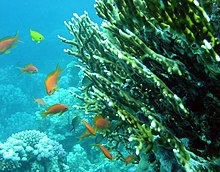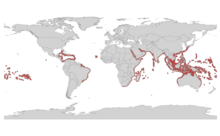
Corals are colonial marine invertebrates within the class Anthozoa of the phylum Cnidaria. They typically form compact colonies of many identical individual polyps. Coral species include the important reef builders that inhabit tropical oceans and secrete calcium carbonate to form a hard skeleton.

The Staghorn coral is a branching, stony coral, within the Order Scleractinia. It is characterized by thick, upright branches which can grow in excess of 2 meters in height and resemble the antlers of a stag, hence the name, Staghorn. It grows within various areas of a reef but is most commonly found within shallow fore and back reefs, as well as patch reefs, where water depths rarely exceed 20 meters. Staghorn corals can exhibit very fast growth, adding up to 5 cm in new skeleton for every 1 cm of existing skeleton each year, making them one of the fastest growing fringe coral species in the Western Atlantic. Due to this fast growth, Acropora cervicornis, serve as one of the most important reef building corals, functioning as marine nurseries for juvenile fish, buffer zones for erosion and storms, and center points of biodiversity in the Western Atlantic.

Millepora dichotoma, the net fire coral, is a species of hydrozoan, consisting of a colony of polyps with a calcareous skeleton.

Porites astreoides, commonly known as mustard hill coral or yellow porites, is a colonial species of stony coral in the family Poritidae.

Pavona duerdeni, the porkchop coral, is a coral that forms clusters of cream-colored lobes or discs. They grow in large colonies, divided into ridges or hillocks. The coral is considered to be uncommon due to its low confirmed abundance, yet they are more commonly found in Hawaii, the Indo-Pacific, and the Tropical Eastern Pacific. They make up some of the largest colonies of corals, and have a slow growth rate, as indicated by their dense skeletons. Their smooth appearance is due to their small corallites growing on their surface.

Coral aquaculture, also known as coral farming or coral gardening, is the cultivation of corals for commercial purposes or coral reef restoration. Aquaculture is showing promise as a tool for restoring coral reefs, which are dying off around the world. The process protects young corals while they are most at risk of dying. Small corals are propagated in nurseries and then replanted on the reef.

Galaxea fascicularis is a species of colonial stony coral in the family Euphylliidae, commonly known as Octopus coral, Fluorescence grass coral, and Galaxy coral among various vernacular names.

Porites lobata, known by the common name lobe coral, is a species of stony coral in the family Poritidae. It is found growing on coral reefs in tropical parts of the Indian and Pacific Oceans.

Millepora alcicornis, or sea ginger, is a species of colonial fire coral with a calcareous skeleton. It is found on shallow water coral reefs in the tropical west Atlantic Ocean. It shows a variety of different morphologies depending on its location. It feeds on plankton and derives part of its energy requirements from microalgae found within its tissues. It is an important member of the reef building community and subject to the same threats as other corals. It can cause painful stings to unwary divers.
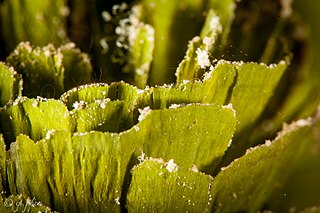
Milleporasquarrosa is a species of fire coral that can be found in the Caribbean Sea as well as in the western Atlantic. They are very common on fringing reefs in patches. They have a smooth surface covered in tiny pores from which polyps protrude. They can reach up to 5 centimeters in height and can range from brown or tan in color with slight purple or red tints. It is commonly known as "box fire coral", which refers to its box-like structure and the stinging sensation felt when touched with a bare hand. These corals are important to reef-building.

Millepora platyphylla is a species of fire coral, a type of hydrocoral, in the family Milleporidae. It is also known by the common names blade fire coral and plate fire coral. It forms a calcium carbonate skeleton and has toxic, defensive polyps that sting. It obtains nutrients by consuming plankton and via symbiosis with photosynthetic algae. The species is found from the Red Sea and East Africa to northern Australia and French Polynesia. It plays an important role in reef-building in the Indo-Pacific region. Depending on its environment, it can have a variety of different forms and structures.

Pocillopora verrucosa, commonly known as cauliflower coral, rasp coral, or knob-horned coral, is a species of stony coral in the family Pocilloporidae. It is native to tropical and subtropical parts of the Indian and Pacific Oceans.
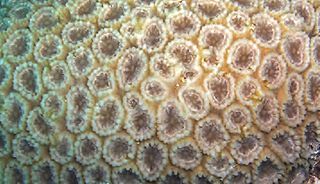
Dipsastraea speciosa is a species of colonial stony coral in the family Merulinidae. It is found in tropical waters of the Indian and Pacific oceans.

Millepora complanata, commonly known as blade fire coral, is a species of fire coral in the family Milleporidae. It is found in shallow waters in the Caribbean Sea where it is a common species. The International Union for Conservation of Nature has assessed its conservation status as being critically endangered.

Millepora tenera is a species of fire coral in the family Milleporidae. It is native to the Red Sea and the western Indo-Pacific region and is a zooxanthellate species with a calcareous skeleton. It was first described in 1949 by the Dutch zoologist Hilbrand Boschma.

Porites cylindrica, commonly known as Hump coral, is a stony coral belonging to the subclass Hexacorallia in the class Anthozoa. Hexacorallia differ from other subclasses in that they have 6 or fewer axes of symmetry. Members of this class possess colonial polyps which can be reef-building, secreting a calcium carbonate skeleton. They are dominant in both inshore reefs and midshelf reefs.
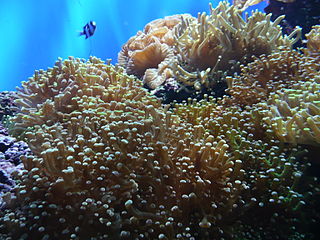
Euphylliidae are known as a family of polyped stony corals under the order Scleractinia.

A corallivore is an animal that feeds on coral. Corallivores are an important group of reef organism because they can influence coral abundance, distribution, and community structure. Corallivores feed on coral using a variety of unique adaptations and strategies. Known corallivores include certain mollusks, annelids, fish, crustaceans, flatworms and echinoderms. The first recorded evidence of corallivory was presented by Charles Darwin in 1842 during his voyage on HMS Beagle in which he found coral in the stomach of two Scarus parrotfish.
